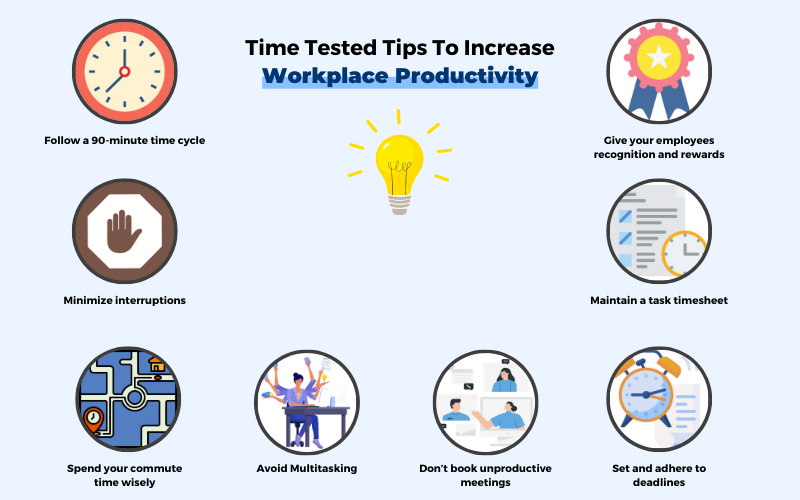
Keeping an eye on productivity allows you to shape operations and hire additional workers or pieces of equipment to meet deadlines. Furthermore, knowing the productivity of your workers allows you to forecast your company’s productiveness and whether you’re competent at meeting tight deadlines or taking on new customers.
The most effective way to measure workplace productivity for your business may take some time and consideration since various measures are available.
In this article, we’ll cover why measuring productivity in the workplace is important, tips to increase workplace productivity, and will let you know about some strategies you can use to start measuring productivity now.
Explore Infographic: 7 Key Statistics on Workplace Productivity and how Automation can help
What is Workplace Productivity?
Workplace productivity refers to the efficiency and effectiveness of individuals and teams in accomplishing tasks and achieving goals within a given timeframe. It encompasses factors such as time management, communication, collaboration, and motivation. By improving workplace productivity, organizations can enhance their bottom line and gain a competitive edge in their industry. To boost productivity in the workplace, businesses can implement strategies such as setting clear goals, providing adequate resources and training, fostering a positive work environment, and leveraging technology and automation.
Your company’s productivity is determined by how efficiently it achieves goals or produces goods and services for customers. The answer to workplace productivity lies in how efficiently tasks and goals are completed in an organization.
An example might be how quickly employees can produce a product in your factory or handle a call from a customer. To increase revenue, remain competitive, and satisfy stakeholders and customers, your workplace productivity must be high.
Specifically, workplace productivity is the result of employee’s output divided by the input
output ÷ input = Productivity
If you want to make a real impact on the productivity of your team, you must know what changes you’ll implement based on all the numbers.
Also Read: Best Productivity Tools to add more hours to your day!
Time Tested Tips To Increase Workplace Productivity

Follow a 90-minute time cycle
Creating 90-minute sessions divided by breaks is one of the most overlooked productivity tips. 90 minutes should be used to accomplish as many tasks as possible by every employee. Then comes a break to recharge. Establishing a rhythm and completing tasks without becoming burnt out can be accomplished by scheduling 90-minute sessions followed by short breaks.
Minimize interruptions
Keep distractions to a minimum while working to stay focused. This is an advantage for remote employees, as office workers are subjected to background noises from devices and coworkers. If necessary, your office team should use soundproof headphones and turn off their phones to be much more focused on tasks and feel empowered.
Also Read: Employee engagement statistics
Spend your commute time wisely
If an employee commutes by public transportation, they can use their phone to review projects or respond to emails. In addition, you may want to consider how you can improve the efficiency of your work. As an alternative, if you drive to work, you can prepare yourself for the day by listening to music or podcasts.
Avoid Multitasking
The late last century’s work ethic emphasized multitasking to meet or beat quotas. To save time and focus on core business functions, many companies now use productivity automation tools to handle multiple tasks simultaneously. When your team is overworked, manual multitasking can result in more errors. Employees who stay focused on a concise task list are more productive.
Also Read: Workflow Automation Statistics and Forecasts you can’t miss!
Make sure you don’t book unproductive meetings
Organizing events that do not accomplish much, such as staff meetings, is another way to improve workplace productivity. Meetings about topics that can be discussed via email can reduce productivity, even if you have an important announcement or need to discuss strategy.
Set and adhere to deadlines
Set deadlines and commit to them if you want to improve your workplace productivity. Staying focused and meeting deadlines regularly demonstrate reliability. Missing deadlines can result in a company losing partners and vendors. To run a successful company, you must ensure that goals are met on time.
Also Read: 15+ ChatGPT Prompts Tips to get the best results
Maintain a task timesheet
Analyzing the time spent by their teams is an important part of business leadership. The number of tasks completed per day or the time it takes to complete a task can be tracked with automation software. Using the data, you can determine which employees are most productive and which need more training or testing. To compensate for lost production, you can adjust personnel in real-time.
Give your employees recognition and rewards
When you recognize an employee for an excellent job, they will be more motivated to work even harder in the future. Your team will be more productive in the workplace and feel fulfilled if you motivate and reward them.
Your employee may also be motivated to give their best effort if you give them an individual pay raise or surprise them with a gift.
Also Read: 20 must-have No-Code Productivity Tools to boost your Efficiency
Techniques For Measuring Workplace Productivity
Every company uses its method of measuring workplace efficiency. This diversity reflects the fact every company has a different structure and focus. Companies often tailor productivity measurement tools to meet their specific needs. Nevertheless, you can expect to encounter several broad categories of productivity measurement during your career. Here’s how you can measure productivity in the workplace:
Focus On Profits
Monitoring the company’s profitability and sales is one way to measure workplace profitability. If your company profits by one million dollars one year and two million the next, it is clear that you have increased productivity. However, it will be necessary to analyze the profit and loss statements of the company to determine what caused it to increase in profitability.
Companies that operate in difficult areas, where it can be hard to gauge the time of an activity, may choose to focus on their profits.
For example, a team that manages ad campaigns for multiple clients. A company might decide that it is more important to secure major clients through high-quality ad campaigns.
They may decide that focusing on the profits the team has brought in is the best way to evaluate the effectiveness of the team. They may compare the profit rate to the total salary paid for more precise measurement.
Also Read: A 10-Step Guide to Enhancing Productivity
Tasks Completed By Workforce
For example, let’s say you have a team managing multiple client ad campaigns. A company might decide it is more important to secure major clients through high-quality ad campaigns.
They may decide that focusing on the profits the team has brought in is the best way to evaluate the effectiveness of the team. They may compare the profit rate to the total salary paid for more precise measurement.
Monitoring Time
Another way to measure workplace productivity is to monitor the time it takes you to complete a task. You can use productivity measurement software online to do this.
Employees are required to record the time they spent on each task in a spreadsheet. This is a common time management method. Managers can evaluate the results over time to determine if productivity increases, decreases, or stays steady. Modern software allows companies to quickly break down time into minutes or seconds, ensuring that labor time is being effectively used.
Also Read: Top 47 No-Code and other Sales Tools to Boost Productivity, Efficiency, and Revenue
Implement Productivity Measurements
You may use peer assessment and feedback to measure productivity in small groups or with individuals who interact frequently. You can use this system to assess the productivity of each employee based on feedback from others.
Every employee must understand the roles and expectations of each member of the team to ensure it succeeds. Employees must feel comfortable giving honest assessments of the performance of their colleagues and must communicate well within the team.
Compare Total Labor Time
One popular way to measure workplace productivity in a factory environment is to compare total labor time (also known as the input) with the number of the output of products. Companies can then calculate the efficiency of their employees by doing this.
This is how you measure workplace productivity. Divide the total product made by the hours worked by all employees. You can then monitor the cost-benefit ratio by using this result.
Monitoring Employee Progress Regularly
Many productivity measurement strategies include regular monitoring of employee progress. Developing customized metrics allows you to keep track of your employees’ progress and make adjustments or set new goals if necessary.
One way is to have a daily check-in with your team or hold a team meeting. It involves meeting daily with your team to discuss your workflow, any issues or to make suggestions for improving your work procedures. You can get a good idea of their productivity by comparing the work they have done in a given time (days or weeks).
Elements of Measuring Workplace Productivity
There are two main elements of a productive workplace, one is the team’s productivity, and another one is the individuals’ productivity. Let us understand how we can measure workplace productivity by measuring teams’ and individuals’ productivity.
Measurement of Team Productivity
It is crucial to establish the input and output of each team to analyze the overall performance and to build productivity improvement plans. How can teamwork be measured effectively? Are you measuring how many tasks were accomplished, how many new customers you acquired, or how much revenue you earned? The answer to that question depends on your company’s profile and the goals your team aims to achieve. The number of completed tasks typically measures a team’s work output.
In contrast, things are much more straightforward when it comes to input. A productivity analysis is often a process that evaluates results over specific time frames: weeks, months, quarters, years, etc., which is why keeping track of it is imperative if you want your analysis to be accurate.
It is also important to know how long your team spends on specific projects or individual tasks to track their performance overall, identify problems, and spot trends before they negatively impact the organization.
In your company, you may introduce time-tracking software so your team can keep track of the time spent on each assignment. Specify time estimates for each task in your software and discuss them in team meetings to remind your employees to stay focused. Overruns should be used to identify the root cause of the problem.
Analytics tools, such as charts and reports, are also useful for measuring team productivity. They can be used to compare time estimates between tasks and projects and to view productivity trends from various angles.
Individual Productivity Measurement
Individual productivity seems to have a little more scope for qualitative evaluation. Because the personal output is much easier to evaluate in terms of quality. But, developing key performance indicators can help in evaluating individuals’ contributions to the company goal.
Time is again the main input type when it comes to evaluating individual productivity. Time is a scarce and non-renewable resource. It’s important to be aware of where you are spending it. How much time is wasted on mundane tasks, non-essential tasks, and distractions each day may surprise you. You could be investing your time in more important projects.
Using the time employees have registered, you can use a productivity and time tracking system to measure individual productivity. One way to manage your employees and measure their output is to discuss time estimates with them. Then log the amounts in the time tracking software and watch how they perform. Ask employees to discuss any overruns. This will help you identify inefficient practices, roadblocks, or slacking workers.
Also Read : How Quixy helped schools of Presidency Group to improve invoice processing time by 40%
The Importance of Productive workplace
The whole idea of a productive workplace sits on an individual’s contribution toward the organization’s goal. Assuming that more work means more productivity is a half-truth; more work with quality results is workplace productivity. Deteriorated work quality with more output is only hurting the company’s profitability in the long run.
Today, technology plays in a big part in increasing the efficiency of an employee. Businesses that are actively investing in equipping employees with value-adding tools are investing in enhancing business productivity.
Conclusion
Workplace productivity isn’t something that you can achieve in a day, but conscious efforts towards improving it and consistently measuring performance will pave the way for it. Automation and technology play a big part in enhancing your business’s overall productivity. With no-code tools like Quixy, business users without technical knowledge can create innovative enterprise-grade solutions, making their work life easier and more focused on achieving the target.
Frequently Asked Question (FAQ’s )
1. How does multitasking affect productivity in the workplace?
Multitasking can negatively impact productivity, as it divides focus and increases the chances of errors. When employees try to juggle too many tasks, their attention becomes fragmented, leading to slower progress and lower-quality results.
2. Why is it essential to track productivity at the workplace?
Measuring workplace productivity is crucial to identify inefficiencies, set clear goals, and optimize workflows. By monitoring productivity, businesses can assess performance, streamline processes, and make informed decisions for improvement.
3. What strategies can I implement to boost workplace productivity?
To boost productivity, try adopting time management techniques, minimizing distractions, setting clear goals, and providing your team with the tools and resources they need. Additionally, fostering a positive work culture and using automation can enhance overall efficiency.
4. Which performance indicators should I focus on to assess my team’s productivity?
Key performance indicators (KPIs) such as task completion rates, project timelines, and quality of work are crucial. You can also track employee engagement, resource utilization, and time spent on each task to evaluate efficiency and overall productivity.
5. How can I enhance productivity without increasing my workforce?
Improving productivity without extra hires can be achieved by streamlining processes, adopting no-code solutions, reducing inefficiencies, and offering employees ongoing training. Automation and empowering employees to take ownership of tasks also contribute to increased efficiency.
Subscribe
Login
Please login to comment
0 Comments
Oldest















